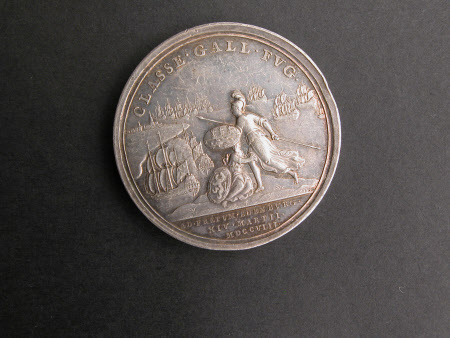The attempted Invasion of Scotland
John Croker (1670 - 1741)
Category
Coins and medals
Date
1708
Materials
Silver
Measurements
395 mm (Diameter)
Place of origin
Great Britain
Order this imageCollection
Osterley Park and House, London
NT 773299.1
Summary
Silver, medal commemorating the attempted invasion of Scotland, by John Croker (1670 - 1741) and Samuel Bull (fl.1707 - 1715), struck London, United Kingdom, 1708. A silver medal by John Croker (1670 - 1741) and Samuel Bull (fl.1707 - 1715) commemorating the defeat of a planned invasion of Scotland by a French-led Jacobite force in 1708. On the obverse, by Croker, is a bust portrait in profile of Queen Anne facing left, her hair tied at top, wearing loose gown. Latin legend ‘Anne by the Grace of God Queen of Great Britain, France and Ireland.’ The artist’s initials are below the bust. The reverse by Samuel Bull depicts Britannia, a helmeted female figure holding a spear and a shield with the royal arms. She hastens forwards, whilst the allegorical figure of Scotia, with a shield with the Scottish lion, crouches at her feet and seems to try to impede her onward rush. Britannia is racing towards the French fleet, which is fleeing and is seen disappearing over the horizon, except for a single ship, the Salisbury, which is being engaged by a British man-of-war. Other British ships at right pursue the French fleet. At left a town, presumably Edinburgh. The Latin legend translates as ‘The French fleet put to flight’ and, in the exergue ‘In the Firth of Edinburgh, 14 March 1708’. The artist’s initials at far right.
Full description
The Act of Union between England and Scotland, which had taken effect on 1 May 1707, had proved unpopular with many people north of the border, providing the Jacobites and their French allies with a pretext for an attempt at invasion. Louis XIV decided to send a substantial invasion force, consisting of five sail of the line, twenty-four frigates, and sixty-six long boats and transports carrying twelve battalions of troops. Prince James, the Old Pretender, travelled with the fleet under the name of the Chevalier St. George, with all the necessary accoutrements for the establishment of his court. However, the expedition would turn out to be a failure. The fleet left Dunkirk on 6 March and, taking advantage of the British fleet under Admiral Byng having been blown off its usual station at Dunkirk, made its way to the Firth of Forth. However, before they could land any troops, the pursuing British fleet was sighted, the immediate response of the French being to cut the cables of their ships and make sail northwards. One ship, the Salisbury, an English prize, remained trapped in the Firth and was taken on 13 March, as illustrated on the reverse of the medal. The remainder of the French fleet tried to reach Inverness, but were blown off course by violent gales and returned to France, arriving home on 27 March. For other medals commemorating the 1708 expedition, from both Government and Jacobite perspectives, see NT 773298 and 773299.2. Jeremy Warren 2019
Provenance
Given to the National Trust in 1993 by George Child Villiers, 9th Earl of Jersey (1910-1998).
Marks and inscriptions
Obverse, legend: ANNA. D: G: MAG: BRI: FRA: ET:HIB: REG: Obverse, below truncation: I C Reverse, legend: CLASSE. GAL. FVG. Reverse, exergue: AD. FRETVM. EDENBVRG. XIV. MARTII. MDCCVIII Reverse, right-hand corner, on rail: SB
Makers and roles
John Croker (1670 - 1741), medallist Samuel Bull (fl.1707 - 1715), medallist
References
Cochran-Patrick 1884: Robert William Cochran-Patrick, Medals of Scotland from the earliest period to the present time, Edinburgh 1884, p. 27, no. 7, Pl. IV Fig. 1. Hawkins, Franks and Grueber 1885: Edward Hawkins, Augustus W. Franks and Herbert A. Grueber (eds.), Medallic Illustrations of the History of Great Britain and Ireland to the death of George II, 2 vols., London 1885, pp. 316-17, no. 141. Woolf 1988: Noel Woolf, The Medallic Record of the Jacobite Movement, London 1988, p. 56, no. 21:1. Eimer 2010: Christopher Eimer, British Commemorative Medals and their Values, London 2010, p. 79, no. 430.
